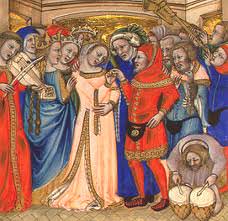The Aesthetics of Marriage in The Canterbury Tales
Kuo, Ju-ping
M.A. Thesis, The Institute of Foreign Languages and Literature, June 23 (2003)
Abstract
This thesis aims to interpret the elements of beauty and art in the marriages portrayed in Geoffrey Chaucer’s Canterbury Tales by means of St. Thomas Aquinas’s theory of beauty and that of art. St. Thomas asserts that beauty consists of three elements: proportion, clarity and integrity, and that art imitates and denotes production. I take beauty and art as the crucial concepts and use analogy as the inquiring tool to examine the imaginary domain between beauty and art as applied to marriage, meanwhile investigating the implied language of intercommunication between aesthetics and marriage. Marriage is taken as a representation of beauty; its different forms and contents portrayed in Chaucer’s various tales will be analyzed so as to see to what extent they reflect and diverge from medieval aesthetic sensitivity and how aesthetic theory can be adopted to interpret medieval marriage. In Chapter One, the theory of “proportion” is applied to the various forms of marriage depicted in the Tales to explore how the marriage of the nobility and that of the commoners will correspond to this element of beauty, as portrayed in “The Clerk’s Tale,” “The Man of Law’s Tale,” “The Second Nun’s Tale,” “The Franklin’s Tale,” “The Merchant’s Tale,” “The Miller’s Tale,” “The Wife of Bath’s Prologue” and her tale. Chapter Two examines the roles the variants of “clarity,” that is, physical and spiritual beauty, play in marriage, and a debate on the coexistence and non-coexistence of physical and spiritual beauty of a wife among the pilgrim-tellers will be demonstrated. Furthermore, in Chapter Three I shall extend the medieval concept of art to that of the “procreative art” in marriage, and explore the relationship between the procreative art and the “integrity” of marriage in the aforementioned tales.
The Aesthetics of Marriage in The Canterbury Tales
Kuo, Ju-ping
M.A. Thesis, The Institute of Foreign Languages and Literature, June 23 (2003)
Abstract
This thesis aims to interpret the elements of beauty and art in the marriages portrayed in Geoffrey Chaucer’s Canterbury Tales by means of St. Thomas Aquinas’s theory of beauty and that of art. St. Thomas asserts that beauty consists of three elements: proportion, clarity and integrity, and that art imitates and denotes production. I take beauty and art as the crucial concepts and use analogy as the inquiring tool to examine the imaginary domain between beauty and art as applied to marriage, meanwhile investigating the implied language of intercommunication between aesthetics and marriage. Marriage is taken as a representation of beauty; its different forms and contents portrayed in Chaucer’s various tales will be analyzed so as to see to what extent they reflect and diverge from medieval aesthetic sensitivity and how aesthetic theory can be adopted to interpret medieval marriage. In Chapter One, the theory of “proportion” is applied to the various forms of marriage depicted in the Tales to explore how the marriage of the nobility and that of the commoners will correspond to this element of beauty, as portrayed in “The Clerk’s Tale,” “The Man of Law’s Tale,” “The Second Nun’s Tale,” “The Franklin’s Tale,” “The Merchant’s Tale,” “The Miller’s Tale,” “The Wife of Bath’s Prologue” and her tale. Chapter Two examines the roles the variants of “clarity,” that is, physical and spiritual beauty, play in marriage, and a debate on the coexistence and non-coexistence of physical and spiritual beauty of a wife among the pilgrim-tellers will be demonstrated. Furthermore, in Chapter Three I shall extend the medieval concept of art to that of the “procreative art” in marriage, and explore the relationship between the procreative art and the “integrity” of marriage in the aforementioned tales.
portrayed in “The Clerk’s Tale,” “The Man of Law’s Tale,” “The Second Nun’s Tale,” “The Franklin’s Tale,” “The Merchant’s Tale,” “The Miller’s Tale,” “The Wife of Bath’s Prologue” and her tale. Chapter Two examines the roles the variants of “clarity,” that is, physical and spiritual beauty, play in marriage, and a debate on the coexistence and non-coexistence of physical and spiritual beauty of a wife among the pilgrim-tellers will be demonstrated. Furthermore, in Chapter Three I shall extend the medieval concept of art to that of the “procreative art” in marriage, and explore the relationship between the procreative art and the “integrity” of marriage in the aforementioned tales.
Click here to read this thesis from The Institute of Foreign Languages and Literature
Subscribe to Medievalverse
Related Posts